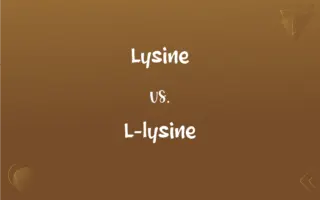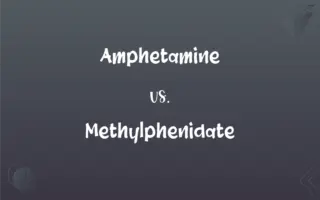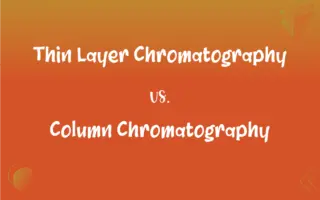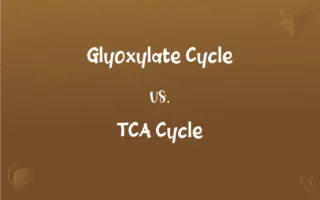Gene vs. DNA: What's the Difference?
Edited by Janet White || By Harlon Moss || Updated on October 29, 2023
A gene is a segment of DNA that codes for a protein or function, while DNA is the molecule containing genetic information.

Key Differences
Gene and DNA are fundamental concepts in molecular biology, each representing distinct but interconnected aspects of genetic material. DNA, which stands for Deoxyribonucleic Acid, is the molecule that carries the genetic instructions for the development, functioning, and reproduction of all known organisms. A gene, on the other hand, is a specific segment or sequence of this DNA molecule that codes for a particular protein or functional RNA molecule, playing a specific role in an organism's traits and functions.
The structure of DNA consists of two long chains of nucleotides twisted into a double helix, where each nucleotide is made up of a sugar, a phosphate group, and a nitrogenous base. These bases are adenine (A), thymine (T), cytosine (C), and guanine (G). A gene, situated within this DNA structure, is a specific sequence of these bases that provides instructions to build molecules that the organism needs, usually proteins.
An organism's genome, which encompasses its entire genetic material, is composed of DNA. This DNA contains thousands to tens of thousands of genes, depending on the species. So, while DNA refers to the entirety of an organism's genetic material, a gene refers to a specific part of the DNA that holds the instructions for a particular function or trait. Therefore, genes are essentially subsections or segments of the broader DNA molecule.
Both DNA and genes are crucial for inheritance. When organisms reproduce, they pass on copies of their DNA, and consequently, their genes, to their offspring. While the DNA ensures the continuity of life and provides the template for the next generation, it's the genes within the DNA that carry the specific information determining traits, characteristics, and functions in the offspring. Variations in genes, occurring naturally or due to mutations, lead to the diversity in traits observed within and between species.
In summation, DNA is the overarching molecular structure that holds an organism's complete set of genetic instructions, while a gene is a specific portion of this DNA, responsible for coding individual traits or functions. Both concepts are integral to understanding genetics, heredity, and the molecular basis of life, with genes serving as the functional units nestled within the vast framework of DNA.
ADVERTISEMENT
Comparison Chart
Definition
Segment coding for protein or function
Molecule containing genetic information
Function
Carries instructions for traits
Stores and transmits genetic information
Location
Part of DNA
Entire genetic material
Structure
Varies in length
Consistent double-helix structure
Role in Heredity
Functional unit of heredity
Blueprint of genetic makeup
ADVERTISEMENT
Gene and DNA Definitions
Gene
A gene is a unit of heredity.
The gene for eye color determines whether someone has blue or brown eyes.
Dna
Capable of replication.
DNA replication is crucial for cell division and growth.
Gene
A segment within DNA.
The BRCA1 gene, a segment of DNA, is linked to breast cancer risk.
Dna
Composed of nucleotide sequences.
The sequence of nucleotides in DNA determines genetic traits.
Gene
Codes for proteins or traits.
The hemoglobin gene codes for the protein in red blood cells.
Dna
DNA is the genetic material of cells.
DNA in a cell's nucleus carries genetic information.
Gene
Subject to mutations.
A mutation in the CFTR gene causes cystic fibrosis.
Dna
Has a double-helix structure.
The double-helix structure of DNA was discovered by Watson and Crick.
Gene
Influences specific traits.
Genes can influence traits like height or hair color.
Dna
Makes up chromosomes.
Human DNA is packaged into 23 pairs of chromosomes.
Gene
A hereditary unit consisting of a sequence of DNA that occupies a specific location on a chromosome and is transcribed into an RNA molecule that may function directly or be translated into an amino acid chain. Genes undergo mutation when their DNA sequences change.
Dna
A nucleic acid that carries the genetic information in cells and some viruses, consisting of two long chains of nucleotides twisted into a double helix and joined by hydrogen bonds between the complementary bases adenine and thymine or cytosine and guanine. DNA sequences are replicated by the cell prior to cell division and may include genes, intergenic spacers, and regions that bind to regulatory proteins.
FAQs
What is a gene?
A gene is a segment of DNA that encodes for a specific trait or function.
How do genes relate to DNA?
Genes are specific sequences within the DNA.
What is DNA?
DNA is the molecule that contains the genetic information of an organism.
What shape is DNA?
DNA has a double-helix structure.
How does DNA replicate?
DNA replicates through a process where the double helix unwinds and each strand serves as a template.
Are all genes the same size?
No, genes vary in length.
What are nucleotides in DNA?
Nucleotides are the building blocks of DNA, consisting of a sugar, a phosphate group, and a base.
Is DNA found in all cells?
Yes, DNA is found in the nucleus of all cells.
What role do genes play in heredity?
Genes are the fundamental units of heredity, passing traits from parents to offspring.
Can DNA testing reveal ancestry?
Yes, DNA testing can provide insights into a person's ancestry.
Do identical twins have identical genes?
Identical twins have nearly identical genes, but small mutations can occur.
Is DNA the same in every cell?
Yes, every cell in an individual's body typically has the same DNA.
Can genes be turned on or off?
Yes, gene expression can be regulated, effectively turning genes on or off.
What are chromosomes made of?
Chromosomes are made of DNA.
Do genes determine all traits?
Genes significantly influence traits, but environmental factors also play a role.
Can genes be mutated?
Yes, genes can undergo mutations, which can alter their function.
What is the human genome?
The human genome is the complete set of human DNA, including all genes.
How is DNA organized in the cell?
DNA is organized into chromosomes within the cell nucleus.
Can genes affect health?
Yes, certain genes can influence susceptibility to diseases.
How many genes do humans have?
Humans have approximately 20,000-25,000 genes.
About Author
Written by
Harlon MossHarlon is a seasoned quality moderator and accomplished content writer for Difference Wiki. An alumnus of the prestigious University of California, he earned his degree in Computer Science. Leveraging his academic background, Harlon brings a meticulous and informed perspective to his work, ensuring content accuracy and excellence.
Edited by
Janet WhiteJanet White has been an esteemed writer and blogger for Difference Wiki. Holding a Master's degree in Science and Medical Journalism from the prestigious Boston University, she has consistently demonstrated her expertise and passion for her field. When she's not immersed in her work, Janet relishes her time exercising, delving into a good book, and cherishing moments with friends and family.




































































